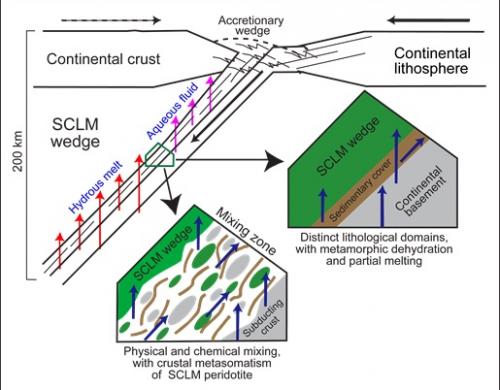 |
| Caption: Two processes occur at the slab-mantle interface in continental subduction channel, with (a) physical mixing to produce the tectonic mélange of metamorphic rocks, and (b) chemical reaction of the overlying subcontinental lithospheric mantle (SCLM) wedge with aqueous fluid and hydrous melt from subducting continental crust. |
| Credit: ©Science China Press |
The plate tectonic theory has been primarily developed in three stages. (1) From continental drift and seafloor spreading to oceanic subduction, laying a physical foundation of the plate tectonic theory. This was achieved by the recognitions that continents would be assembled to build a supercontinent Pangea with subsequent breakup to yield the present configuration, lithospheric plates buoyantly move on the asthenospheric mantle, and oceanic crust is subducted along trenches into the mantle. (2) From oceanic subduction to continental subduction and collision orogeny, with the first round of revolution to the plate tectonic theory due to the recognition of continental deep subduction to mantle depths. While deeply subducted oceanic crust was processed in the mantle and the returned to the surface by mafic magmatism, deeply subducted continental crust underwent ultrahigh pressure metamorphism at mantle depths and then exhumed to the surface as coherent mélanges. This provides a geodynamic framework of tectonic processes for continental accretion and assemblage through arc-continent and continent-continent collision orogenies. (3) From continental collision and marginal orogeny to intracontinental reworking, emphasizing the inheritance of orogenic materials in postcollisional stages. While continental collision results in continental accretion through marginal orogeny, intercontinental orogens are converted to intracontinental orogens. The deeply subducted continental crust is processed in subduction channel underlying the mantle wedge, with partial return to the surface. These have thrown new lights on developing the plate tectonic theory to encompass the continental tectonics, and thus directed further study toward solution to such questions as how thinning of the orogenic lithosphere and upwelling of the asthenospheric mantle affect postcollisional reworking of the intracontinental materials.
Finding of ultrahigh pressure index minerals such as coesite and diamond in metamorphic rocks of continental supercrustal protolith demonstrate that these rock were subducted to mantle depths for ultrahigh pressure metamorphism and then returned back to the surface. The recognition of continental deep subduction by Earth scientists has not only developed the plate tectonic theory, but also expanded the chemical geodynamics focusing on the recycling of crustal material. The study of ultrahigh pressure metamorphic rocks has made prominent progress in many aspects, achieving the recognitions that the processes of continental seduction and exhumation have caused not only various types of structural deformation and mineralogical reaction but also different extents of metamorphic dehydration and partial melting (Fig. 1). By means of studying various rocks in continental collision orogens, Earth scientists have set the geodynamic link between the subduction and exhumation of continental crust and the building of collision orogens. Furthermore, it is established that bulk melting of the deeply subducted continental crust gives rise to granitic rocks whereas partial melting of the subducting supracrustal rocks produces felsic melt that reacts with the overlying mantle wedge peridotite to generate fertile and enriched mantle sources for mafic magmatism after their storage in different periods.
A research team at School of Earth and Space Sciences in University of Science and Technology of China has taken the rocks of continental collision orogens as the object, and performed a great deal of investigations from field observations and laboratory analyses. This leads to a tectonic analysis of geological processes in continental subduction factory, which is published in Chinese Science Bulletin 2013 (26) in the title "Continental subduction channel processes: Plate interface interaction during continental collision". Leader of this team is Professor ZHENG Yongfei, Academician of the Chinese Academy of Sciences at Key Laboratory of Crust-Mantle Materials and Environments. Major participants are Prof. ZHAO Zifu and Dr. CHEN Yixiang. Earth scientists of China have made a series of prominent progresses in the forefront and hotspot field of subduction channel, and their studies have exemplified successful applications of new techniques, new methods and new ideas to development of the plate tectonic theory.
The recognition of continental deep subduction and ultrahigh pressure metamorphism has provided not only a turning point in developing the plate tectonic theory, but also an excellent opportunity to study the time and mechanism of reworking continental lithosphere. It is intriguing to ask the following questions: (1) how are crustal slices detached at different depths and exhumed during continental subduction? (2) how do physical mixing and chemical reaction proceed between the deeply subducted crust and the overlying mantle wedge? (3) how are energy exchange and matter transfer realized at the plate interface of subduction zone? Prof. Zheng said, to study subduction channel processes, to determine the physical mixing and chemical reaction between the deeply subducted crust and the overlying mantle wedge under ultrahigh pressure conditions, and to understand the interaction at the plate interface of continental subduction zone and its associated fluid action and element transport, are a key to unravel such mysteries of Earth.
###
Source article:
Zheng Y F, Zhao Z F, Chen Y X. Continental subduction channel processes: Plate interface interaction during continental collision. Chinese Science Bulletin, 2013, 58, doi: 10.1007/s11434-013-6066-x
Website: http://link.springer.com/article/10.1007/s11434-013-6066-x
Science China Press Co., Ltd. (SCP) is a scientific journal publishing company of the Chinese Academy of Sciences (CAS). For 50 years, SCP takes its mission to present to the world the best achievements by Chinese scientists on various fields of natural sciences researches. http://www.scichina.com/